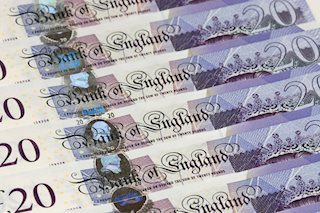GBP/USD rebounds above 1.2850 ahead of US PCE data
|
- GBP/USD holds positive ground around 1.2860 in Friday’s Asian session.
- The US economy grew at an annual rate of 2.8% in Q2, stronger than expected.
- The BoE is expected to cut rates for the first time in more than four years at its policy meeting next week.
The GBP/USD pair gains traction near 1.2860 amid the weaker Greenback, snapping the three-day losing streak during the Asian trading hours on Friday. However, the potential upside of the major pair seems limited as market players expect the Bank of England (BoE) to cut interest rates in August.
The US economy grew faster than expected in the second quarter (Q2), according to the US Department of Commerce in an advance estimate released on Thursday. The US Gross Domestic Product (GDP) grows at an annual rate of 2.8% in Q2, marking an acceleration from 1.4% growth in Q1. This figure came in stronger than the estimation of 2%.
However, the expectations of a September interest rate cut from the Federal Reserve (Fed) remain intact. Traders will closely watch the release of the US Personal Consumption Expenditures (PCE) Price Index data for June, which is due on Friday.
Furthermore, the US weekly Initial Jobless Claims for the week ending July 20 rose by 235,000, compared to the previous week of 243,000. This figure was below the consensus of 238,000. Meanwhile, US Durable Goods Orders declined by 6.6% MoM in June from a 0.1% increase in May, weaker than the 0.3% expected.
On the GBP’s front, the Bank of England (BoE) is anticipated to cut the bank rate to 5% at its August meeting next week as inflation is expected to hover around the central bank target, according to a majority of economists in a Reuters poll. Additionally, UBS analysts noted that the BoE is expected to deliver the first 25 basis points (bps) cut in early August and another 25 bps in November, bringing the interest rate to 4.75% by the end of 2024. “The key reason why we expect the MPC to cut rates is the recent data,” said UBS analysts.
Pound Sterling FAQs
The Pound Sterling (GBP) is the oldest currency in the world (886 AD) and the official currency of the United Kingdom. It is the fourth most traded unit for foreign exchange (FX) in the world, accounting for 12% of all transactions, averaging $630 billion a day, according to 2022 data. Its key trading pairs are GBP/USD, aka ‘Cable’, which accounts for 11% of FX, GBP/JPY, or the ‘Dragon’ as it is known by traders (3%), and EUR/GBP (2%). The Pound Sterling is issued by the Bank of England (BoE).
The single most important factor influencing the value of the Pound Sterling is monetary policy decided by the Bank of England. The BoE bases its decisions on whether it has achieved its primary goal of “price stability” – a steady inflation rate of around 2%. Its primary tool for achieving this is the adjustment of interest rates. When inflation is too high, the BoE will try to rein it in by raising interest rates, making it more expensive for people and businesses to access credit. This is generally positive for GBP, as higher interest rates make the UK a more attractive place for global investors to park their money. When inflation falls too low it is a sign economic growth is slowing. In this scenario, the BoE will consider lowering interest rates to cheapen credit so businesses will borrow more to invest in growth-generating projects.
Data releases gauge the health of the economy and can impact the value of the Pound Sterling. Indicators such as GDP, Manufacturing and Services PMIs, and employment can all influence the direction of the GBP. A strong economy is good for Sterling. Not only does it attract more foreign investment but it may encourage the BoE to put up interest rates, which will directly strengthen GBP. Otherwise, if economic data is weak, the Pound Sterling is likely to fall.
Another significant data release for the Pound Sterling is the Trade Balance. This indicator measures the difference between what a country earns from its exports and what it spends on imports over a given period. If a country produces highly sought-after exports, its currency will benefit purely from the extra demand created from foreign buyers seeking to purchase these goods. Therefore, a positive net Trade Balance strengthens a currency and vice versa for a negative balance.
Information on these pages contains forward-looking statements that involve risks and uncertainties. Markets and instruments profiled on this page are for informational purposes only and should not in any way come across as a recommendation to buy or sell in these assets. You should do your own thorough research before making any investment decisions. FXStreet does not in any way guarantee that this information is free from mistakes, errors, or material misstatements. It also does not guarantee that this information is of a timely nature. Investing in Open Markets involves a great deal of risk, including the loss of all or a portion of your investment, as well as emotional distress. All risks, losses and costs associated with investing, including total loss of principal, are your responsibility. The views and opinions expressed in this article are those of the authors and do not necessarily reflect the official policy or position of FXStreet nor its advertisers.